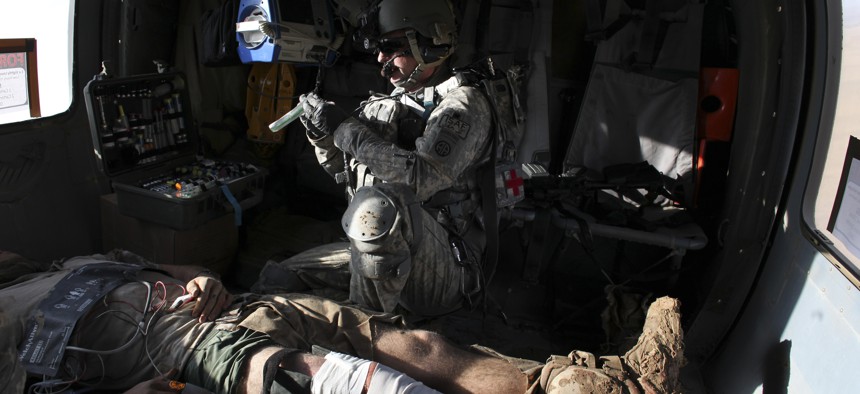
Airborne in a Black Hawk helicopter, U.S. Army flight medic Staff Sgt. Robert B. Cowdrey, of La Junta, Colo., with Charlie Company, All American Dustoff, attends to a U.S. Marine wounded in a rocket-propelled grenade attack, over Marjah, Helmand province, AP / Brennan Linsley
Special Operations Forces Are Changing Combat Medicine With Jury-Rigged Hospitals and Freeze-Dried Blood
Fighting that takes place far from friendly hospitals is driving experimental techniques that may one day see wide adoption by the Pentagon.
Get shot or wounded within an hour of a hospital and your chances of survival are a lot better than if you were farther away. But for U.S. Special Operations Forces and their partners, “farther away” is where the fighting happens, sometimes hundreds of miles from the nearest friendly hospital. So they’re closing the gap in places like Syria using jury-rigged emergency rooms that fit on the back of trucks and lots of freeze-dried, powdered blood.
James Smith, the acquisition executive for U.S. Special Operations Forces Command, or SOCOM, described a recent incident in Syria. U.S. troops were supporting a partner military fighting “well outside of the golden hour” — meaning more than an hour away from a useful hospital..
But the U.S. forces had a Mobile Technical Repair Complex, or MTRC — basically a tent that comes with a lathe, some drilling equipment, and 3D printer to rapidly manufacture tools or parts you might need. SOCOM has 13 such complexes deployed in remote places around the world, along with technicians and engineers to run them.
To help the partner force in Syria, the MTRC crew welded together two transportable sleeping units and put them in the back of a flatbed truck, along with packets of freeze-dried blood. Soldiers maneuvered the makeshift medical facility to within a couple hundred meters of the front lines, Smith said during the annual SOFIC conference in Tampa, Florida, this week.
“These guys with their surgical teams, our Operational Detachment Alphas have great medical capability just with the physician assistants that are part of the teams,” he said. “They were doing combat medicine within a few hundred meters” of the fighting he said, and “well within the golden hour in support of this partnered force.”
The use of freeze-dried plasma is likely to become common on future battlefields. The French and German militaries use it already. The U.S. Army is working on its own version, which will need FDA approval before it sees widespread use by American forces.
USSOCOM got special permission to use a French-produced freeze-dried plasma product from a company called Teleflex, with a small number of teams in very, very tough environments, said Smith, which they’ve been doing for years. The AP reported in November that U.S. Special Forces had used the plasma 24 times in five years. Some 15 of those patients lived long enough to be transferred to a hospital.
“You can’t carry plasma around on battlefields and into remote austere locations. You’ve got to keep it refrigerated; keep it fresh. But when you use freeze-dried plasma and you can reconstitute it with water,” he said.“You take that in combination with these mobile technology repair complexes, these shops in a box that we have. all of a sudden you’ve got something that can save lives.”
But even the French freeze-dried blood doesn’t quite fit their needs because it comes in glass containers, not quite suitable for desert gunfights. Smith says that SOCOM’s experiences will likely help the Army in its pursuit of FDA approval for a product that is, perhaps, still years away from seeing wide use.




